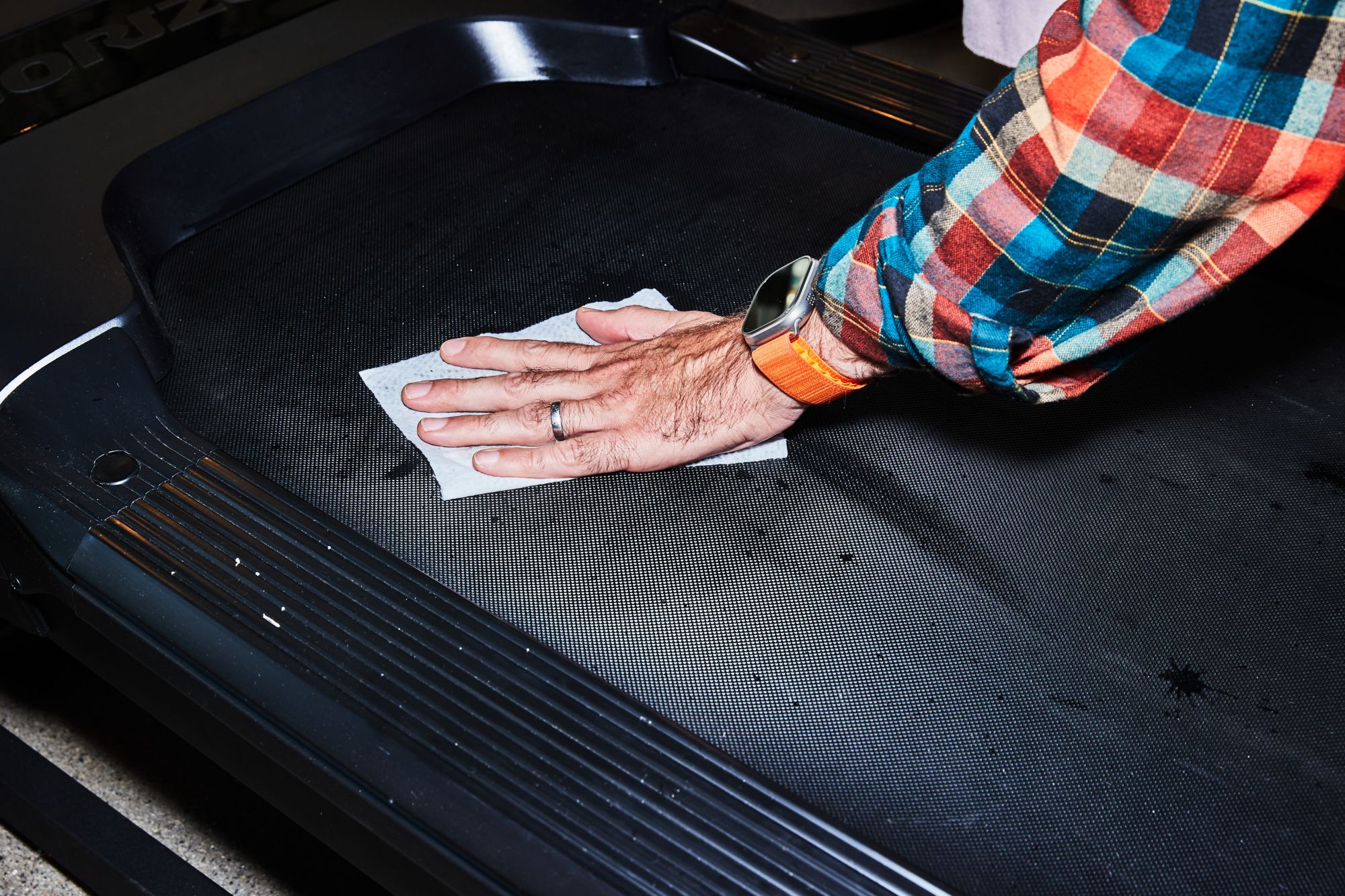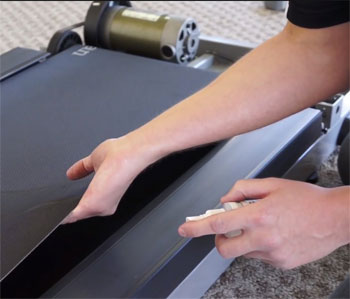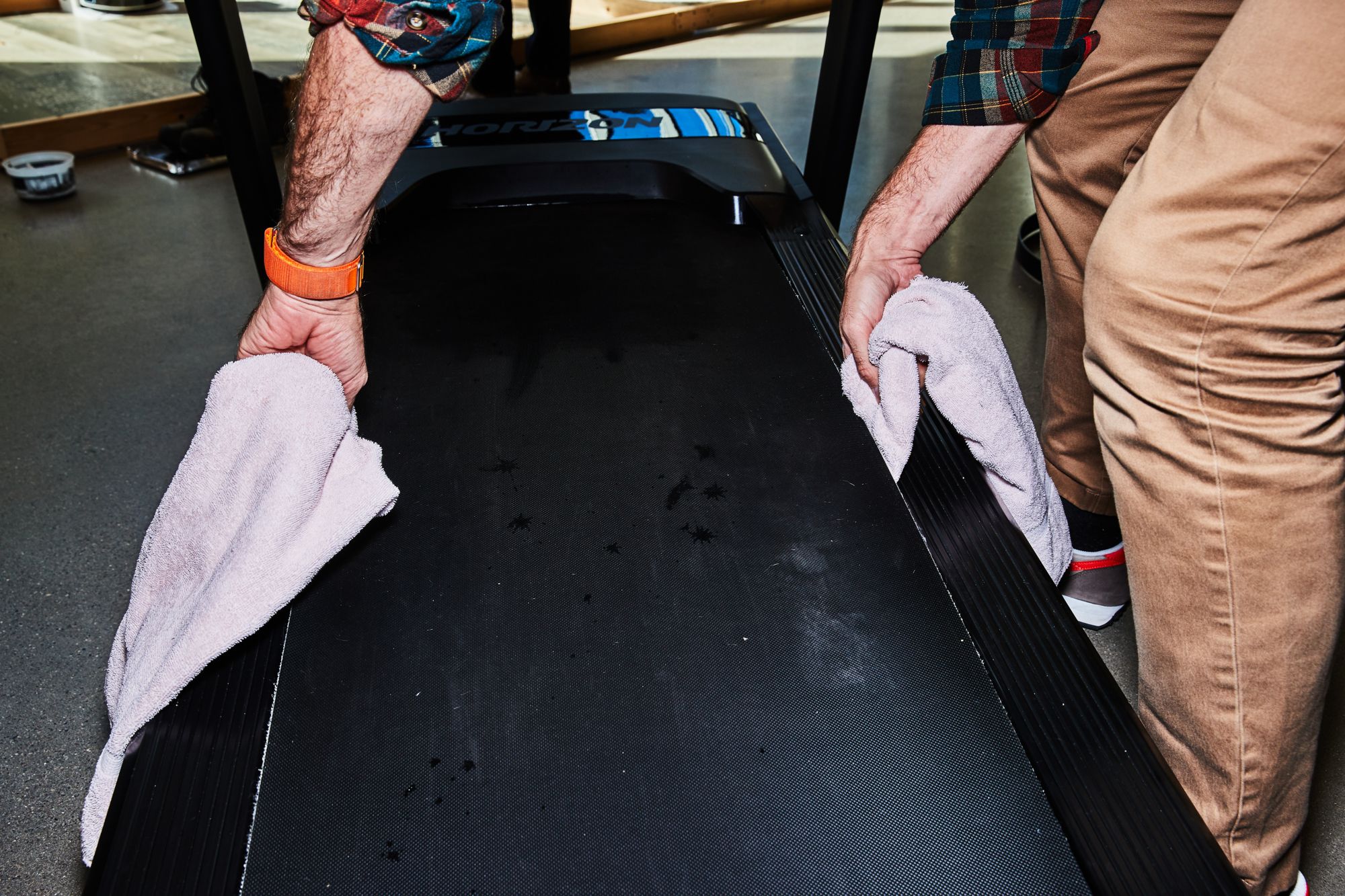In this article, you will learn the step-by-step process of cleaning your treadmill belt. Whether you’re an avid runner or just starting on your fitness journey, keeping your treadmill in top condition is essential for a smooth and enjoyable workout. We understand that searching for the right information can be time-consuming, so we’ve condensed all the necessary steps into one comprehensive guide. By following these simple instructions, you’ll be able to maintain your treadmill belt’s longevity and ensure optimal performance during every workout. So, let’s dive right in and discover how to clean your treadmill belt effectively!

This image is property of hips.hearstapps.com.
1. Preparing for Cleaning
Cleaning your treadmill belt is an essential part of maintaining its performance and prolonging its lifespan. Before you begin the cleaning process, it is important to make sure you have everything you need and prepare the space properly.
1.1 Clearing the Space
Start by clearing the area surrounding your treadmill. Remove any objects or obstacles that may hinder your cleaning process. This includes workout mats, weights, or any other items in close proximity to the treadmill. Ensuring a clear space will make it easier to access all areas of the belt and prevent accidents.
1.2 Powering Off the Treadmill
Before you start cleaning, make sure to turn off and unplug your treadmill. This step is crucial for safety reasons. It will prevent any accidental starts while you are handling the belt and also protect you from any electrical hazards. Take a moment to double-check that the power supply is completely disconnected.
1.3 Gathering Necessary Supplies
To effectively clean your treadmill belt, you will need a few supplies. Gather a vacuum cleaner with a hose attachment, a soft-bristled brush, a dry cloth, a mild detergent, vinegar, baking soda, a bucket, a damp cloth, and a lubricant recommended by the treadmill manufacturer. Having all these supplies ready will ensure a smooth cleaning process without interruptions.
2. Removing Debris and Dust
Dust and debris can accumulate on your treadmill belt over time, affecting its performance and potentially damaging the motor. Here’s how you can effectively remove unwanted particles and ensure a clean working surface.
2.1 Using a Vacuum Cleaner
Start by using a vacuum cleaner with a hose attachment to remove loose dust and debris from the belt. Run the vacuum cleaner over the entire length of the belt, paying extra attention to the edges and corners. The suction power of the vacuum will help pull out the dirt, making it easier to clean further.
2.2 Brushing with a Soft-Bristled Brush
Next, take a soft-bristled brush and gently brush the surface of the treadmill belt. This step will help loosen any remaining particles stuck to the belt. Make sure to brush in the direction of the belt’s movement to avoid causing any damage. Be thorough and cover the entire length and width of the belt.
2.3 Wiping with a Dry Cloth
Once you have removed the loose debris, use a dry cloth to wipe the surface of the treadmill belt. This will help remove any remaining dust and give it a clean, polished look. Wipe both the top and bottom surfaces of the belt to ensure a thorough cleaning.

This image is property of standupworkstyle.com.
3. Cleaning with Mild Detergent
For a deeper clean, you can use a mild detergent solution to remove any stubborn dirt or stains from your treadmill belt. Follow these steps to effectively clean the belt using a detergent solution.
3.1 Diluting the Detergent
In a bucket, mix a small amount of mild detergent with warm water. Be sure to follow the manufacturer’s instructions for the appropriate detergent-to-water ratio. Stir the solution gently until it is well mixed and foamy.
3.2 Applying the Solution
Dip a clean cloth or sponge into the detergent solution, ensuring it is damp but not soaking wet. Wring out any excess liquid to avoid dripping. Starting at one end of the treadmill belt, swipe the cloth along the entire length, applying the detergent solution evenly. Repeat this process on both the top and bottom surfaces of the belt.
3.3 Scrubbing Gently
Using the soft-bristled brush, gently scrub the treadmill belt in circular motions. This will help loosen any dirt or stains embedded in the belt’s surface. Avoid applying excessive pressure or using abrasive cleaning tools that may damage the belt. Continue scrubbing until you have covered the entire length and width of the belt.
3.4 Wiping with a Damp Cloth
After scrubbing, dampen a clean cloth with plain water. Wipe the treadmill belt thoroughly to remove any detergent residue. Rinse the cloth frequently to prevent spreading the residue. Make sure to wipe both the top and bottom surfaces of the belt until it feels clean and free from any residue.
4. Cleaning with Vinegar Solution
Vinegar is known for its natural cleaning properties and can be used to effectively clean and disinfect your treadmill belt. Follow these steps to clean your belt using a vinegar solution.
4.1 Mixing Vinegar Solution
In a bucket, mix equal parts of white vinegar and water. Stir the solution gently to ensure it is well combined.
4.2 Applying the Solution
Dip a clean cloth or sponge into the vinegar solution, making sure it is damp but not dripping. Start at one end of the treadmill belt and swipe the cloth along the entire length, applying the vinegar solution evenly. Repeat the process on both sides of the belt.
4.3 Scrubbing for Stains
If there are any stubborn stains on the belt, use the soft-bristled brush and gently scrub the affected areas using the vinegar solution. The acidity of the vinegar will help break down the stains and remove them effectively. Take care not to scrub too aggressively to avoid damaging the belt.
4.4 Wiping with a Damp Cloth
After scrubbing, dampen a clean cloth with plain water and wipe the treadmill belt to remove any vinegar residue. Rinse the cloth frequently to prevent spreading the residue. Make sure to wipe both the top and bottom surfaces of the belt until it feels clean and free from any vinegar residue.

This image is property of hips.hearstapps.com.
5. Removing Stubborn Stains
If you encounter stubborn stains that are not easily removed with mild detergent or vinegar, you can use a baking soda paste to tackle them effectively.
5.1 Using Baking Soda Paste
Create a paste by mixing baking soda with a small amount of water. Apply the paste directly to the stubborn stains on the belt and let it sit for a few minutes. Then, use the soft-bristled brush to gently scrub the stains. The abrasive properties of baking soda will help lift the stains without damaging the belt. Finally, wipe away the paste with a damp cloth and rinse the belt thoroughly.
6. Drying the Belt
After cleaning, it is important to ensure that the treadmill belt is completely dry before using it. Here’s how you can properly dry the belt to prevent any moisture-related problems.
6.1 Air Drying Naturally
Allow the treadmill belt to air dry naturally. Keeping the treadmill in a well-ventilated area will aid in the drying process. Avoid using any heat sources such as hair dryers or heaters to speed up drying, as this may damage the belt. Depending on the humidity levels and airflow in the room, it may take a few hours for the belt to dry completely.

This image is property of i.ytimg.com.
7. Lubricating the Belt
Regular lubrication is essential to maintain the smooth operation of your treadmill belt. Follow these steps to properly lubricate the belt and reduce friction.
7.1 Checking the Manufacturer’s Instructions
Refer to the manufacturer’s instructions or user manual to determine the recommended lubricant for your specific treadmill model. Different treadmills may require different types of lubricants, so it is important to use the right one to avoid any damage.
7.2 Applying Lubricant
Apply the lubricant to the treadmill belt according to the manufacturer’s instructions. Typically, you will need to apply a few drops of lubricant on each side of the belt, evenly spaced along its length. After applying the lubricant, run the treadmill for a few minutes at a slow speed to allow the lubricant to distribute evenly across the belt.
8. Inspecting for Damages
Regular inspections can help you identify any potential issues or damages to your treadmill belt. Here’s what you should look out for during your inspection.
8.1 Checking for Fraying Edges
Inspect the edges of the treadmill belt for any signs of fraying or unraveling. Fraying edges can indicate excessive wear and may require belt replacement.
8.2 Examining for Cracks
Carefully examine the entire surface of the treadmill belt for any cracks or holes. Cracks can lead to belt failure and pose safety risks. If you notice any cracks, it is important to address the issue promptly.
8.3 Inspecting the Tension
Check the tension of the treadmill belt by pressing down with your hand in the middle of the belt. It should have a slight give but not feel too loose or too tight. If you notice any significant changes in tension, consult the manufacturer’s instructions for appropriate adjustments.

This image is property of www.topfitnessmag.com.
9. Reassembling and Testing
Once you have completed the cleaning and drying process, it’s time to reassemble your treadmill and ensure it is in proper working condition.
9.1 Reattaching Any Removed Parts
If you removed any parts or accessories during the cleaning process, carefully reattach them to the treadmill. Follow the manufacturer’s instructions to ensure proper placement and alignment.
9.2 Reconnecting the Power
Plug your treadmill back into the power outlet and turn it on. Ensure that all the controls and features are functioning correctly.
9.3 Testing the Belt
Before using the treadmill, take a few moments to test the belt. Start at a slow speed and gradually increase it to check for any abnormal noises, vibrations, or slippage. If you notice any issues, refer to the manufacturer’s troubleshooting guide or contact their customer support for assistance.
10. Regular Maintenance Tips
To keep your treadmill belt in optimal condition, it is important to follow these regular maintenance tips.
10.1 Cleaning Frequency
Clean your treadmill belt at least once a month or more frequently if you use it regularly. Regular cleaning will prevent the buildup of dirt and debris, ensuring smooth operation and prolonging the lifespan of your treadmill.
10.2 Proper Usage
Follow the manufacturer’s guidelines for proper treadmill usage. Avoid overloading the treadmill, running with dirty shoes, or using excessive force on the belt. These practices can cause premature wear and damage.
10.3 Belt Alignment
Regularly check and adjust the alignment of the treadmill belt. Misalignment can cause uneven wear and affect the performance of the treadmill. Consult the manufacturer’s instructions for guidance on adjusting the belt alignment.
10.4 Regular Inspections
Perform regular inspections of your treadmill belt, motor, and other components to identify any signs of wear or damage. Promptly address any issues to prevent further damage and ensure your safety.
By following these comprehensive cleaning steps and implementing regular maintenance practices, you can keep your treadmill belt clean, functional, and in optimal condition for a long time. Enjoy your workouts knowing that your treadmill is well-maintained and ready to support your fitness journey!





